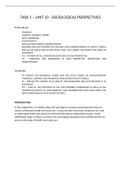TASK 1 – UNIT 10 - SOCIOLOGICAL PERSPECTIVES
P1, P2, M1, D1 -
- FEMINISM
- MARXISM /CONFLICT THEORY
- POST MODERNISM
- FUNCTIONALIST
- SOCIAL ACTION THEORY/ INTERACTIONISM
- DESCRIBE HOW EACH PERSPECTIVE EXPLAINS THEIR UNDERSTANDING OF SOCIETY, NORMS
AND VALUES AND IN HEALTH AND SOCIAL CARE. ALSO LINKING THE PERSPECTIVES IDEAS TO
PLACEMENT
- M1 – IN MORE DETAIL, LIMITATIONS/CRITICISMS OF EACH PERSPECTIVE.
- D1 – STRENGTHS AND WEAKNESSES OF EACH PERSPECTIVE, ADVANTAGES AND
DISADVANTAGES.
P3, P4, M2 –
- P4- EXPLAIN THE BIOMEDICAL MODEL AND THE SOCIAL MODEL OR COMPLEMENTARY
THERAPIES, COMPARE THE DIFFERENCES/SIMILARITIES OF BOTH MODELS.
- P4 – EXPLAIN THE CONCEPT OF ILL-HEALTH, AND DISABILITIES, AND ALSO RELATING IT TO
PLACEMENT.
- M2 – LOOK AT THE CRITICISMS OF THE TWO DIFFERENT APPROACHES AS WELL AS THE
CONCEPTS OF HEALTH, ILL AND DISABILITIY. ALSO CONSIDER HOW THIS COULD AFFECT THE
SERVICE PROVISION IN YOUR CHOSEN SETTING…
INTRODUCTION
In this assignment, I've written about the sociological concepts and perspectives that are
used to understand health and social care. I'll also describe how these viewpoints are used
to understand health and social care and how they help us comprehend society. I have
additionally made an effort to analyse how sociological viewpoints have influenced how we
perceive the study of health and social care.
, P1, P2, M1, D1 – EXPLAIN HOW SOCIOLOGICAL PERPSECTIVES ARE APPLIED TO THE
UNDERSTANDING OF HEALTH AND SOCIAL CARE
Socialisation the concept that a lot of human behaviour is learned through a process of
socialisation is the meaning of sociology. This is the process by which people learn the
culture of their society, which often consists of language, values, and customary and
accepted ways of behaving. For any society to function properly norms and values are put in
place. The Enabled centre that I work in have some strict policies and procedures in place,
no service user would be discriminated against based on their disabilities, sexual
orientation, age and religion, the enabled centre values religion and beliefs, they celebrate
all religions
There are 2 types of socialisations, these are the primary and secondary socialisation,
secondary socialisation is the process by which the individuals develop their behaviour
through peer groups, religious groups and their school. While primary socialisation is the
process when the child/infant learns about beliefs and values and the attitude of their
cultures through their family. There are different social groups that sociologist’s study and
how this groups influence an individual's beliefs, attitudes, and values and ways of life. They
are also focused on different how they are different inequalities within this groups.
There are 5 key perspectives which relates to norms and values of the society, with each
different opinions on society firstly is
FEMINISM THOERY
This theory sees the conflict between men and women as a series of structural conflict
approaches. There is a perception that many social institutions oppress and/or disadvantage
women.. (“Feminist Theory in Sociology: Definition, Types & Principles”). There are 3 types
of feminism, which are Marxist feminism, radical feminism and liberal feminism. Marxist
feminism see women, especially working-class women as being oppressed by capitalism and
the patriarchal society, they say women are to produce the next generation of worker and
are there to meet the emotional, physical and social needs of their children so they can
work in the offices or factories in the future. Men tend to be radical feminists; they consider
the nuclear family as a patriarchal institution and the socialisation of women as housewives
and mothers as forms of oppression. Liberal feminism would argue the fact that changes
have taken place, believe that hanging legislations like the Equal Pay Act 1970, or the Sex
Discrimination Act 1975, there is more equality. And they believe that if there are more
changes to legislations there will be improvements.
Feminist also addresses how a common problem in any health care setting is the assumption
that nearly every woman wearing a ward coat is either a nurse or an assistant. This
assumption has been connected to the stereotyped gender roles that present men as
providers and women as caregivers, portraying men as doctors in place of women. This
stereotype also includes men, who are thought to be unfit for the profession of nursing.
Female healthcare workers still face a variety of difficulties, such as sexism, obstacles to
advancement and employing more female medical professionals, and verbally abusive
remarks. The limitation of this theory is feminist tend to assume that all women share the




